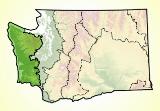 © Pete Saloutos/Panoramic Images (Washington Title Image Large)
© Pete Saloutos/Panoramic Images (Washington Title Image Large)

HomeExplore Places and TopicsFind Your StateWashingtonNatural GeographyEcoregionsNorthwest CoastBiodiversity Features
Northwest Coast Outstanding Biodiversity Features
- Geographic separation and unique species. Isolated by the Pacific Ocean, the Strait of Juan de Fuca, and the Puget Sound, a host of flora and fauna have evolved in this ecoregion. The Olympic Mountains offer the only home in the world to endemic rodents and trout and to rare plants, such as Olympic Mountain synthyris, Piper's bellflower, and Flett's violet.
- Tracts of verdant temperate rainforests. Some of the wettest places in the lower 48 are found here. Its rainforest of immense conifers drips with epiphytic ferns, mosses, and lichens. Scientists estimate that the world’s largest remaining stands of temperate rainforest, found within Olympic National Park, hold more living biomass than any tropical forest.
- Three vital estuaries for waterfowl, shorebirds, and anadromous fish. The Columbia River Estuary, largest in the Northwest, is critical for waterfowl, sea-run fish, and the endangered Columbia white-tailed deer. Willapa Bay is home to 47,000 acres of marsh, sandflats, and mudflats. Grays Harbor is both a vital nursery for young salmon and a stopover for tens of thousands of migrating shorebirds.
- Iconic marine species facing threats. Some of the most remarkable animals of the Northwest Coast—orcas, Steller sea lions, sea otters, loons, snowy plovers, and marbled murrelets—are species at risk.
For details of this ecoregion within Washington, click a subheading in the left column.
View the more general description of this ecoregion in North America






